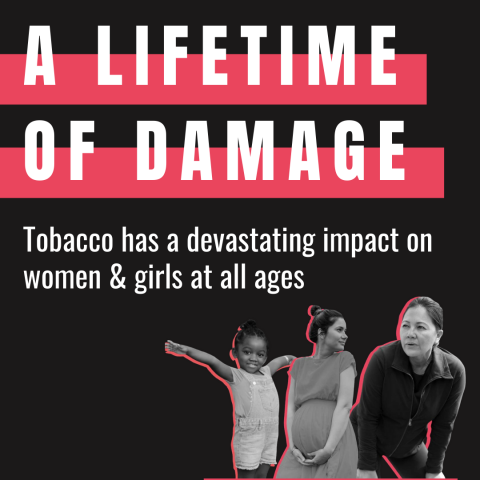
Check out the new report at TFK.org/womensreport
May is Women’s Health Month, and there is no better time to take action to help prevent tobacco use in women and girls and to help current tobacco users quit.
More than 16 million women and girls in the United States currently smoke, putting them at risk for serious and deadly diseases. Over 200,000 women die in the U.S. every year due to smoking and exposure to secondhand smoke. Meanwhile, youth e-cigarette use has skyrocketed to what the U.S. Surgeon General and the FDA have called “epidemic” levels, with nearly 1 in 5 high school girls in the U.S. now using e-cigarettes.
The tobacco industry has long understood the importance of recruiting women and girls as customers and has a long history of targeting them. Extensive market research on the attitudes of women has helped tobacco companies better understand how to target their products and advertise to this important group of potential customers. In the same way that tobacco companies have aggressively targeted Black Americans with campaigns for menthol cigarettes, they have targeted women and girls with specific brands and campaigns that use themes of beauty, sophistication, weight loss, fashion and freedom that continue today.
While the digital age has brought new tobacco products and tactics, the marketing still echoes themes common over the past several decades. Newer products like Juul and blu e-cigarettes and Philip Morris’ IQOS heated cigarette reach young women and girls through social media influencers, special parties and events, and celebrity endorsements.
Devastating consequences of tobacco use occur at every stage of a woman’s life. Tobacco use can lead to nicotine addiction for young girls. Nicotine can have lasting and damaging effects on adolescent brain development and girls who smoke also have reduced rates of lung growth and are at risk of early cardiovascular damage.
Additionally, smoking can impact a woman’s ability to become pregnant and can cause serious pregnancy complications including miscarriage, ectopic pregnancy, premature delivery, low birthweight, and infant mortality. Smoking is also a primary cause of deadly and debilitating chronic diseases and causes serious health harms later in life, like heart disease, cancer, diabetes, and Alzheimer’s disease.
So, what policy solutions can help protect women and girls from tobacco?
- Expanding the availability and promotion of smoking cessation treatments and ensuring women receive advice to quit from their healthcare providers.
- Eliminating all flavored tobacco products, including menthol cigarettes and flavored e-cigarettes. Flavors mask the harshness and increase the appeal of tobacco products, making it easier for new users – particularly youth – to try these products and ultimately become addicted. Menthol also makes cigarettes more addictive and harder to quit. The FDA recently took a major step forward by announcing that it will initiate rulemaking to prohibit menthol cigarettes and flavored cigars.
- Implementing other proven policy solutions, including cigarette tax increases, well-funded tobacco prevention and cessation programs, and comprehensive smoke-free workplace laws.
You can learn more about the impact of tobacco on women and girls in the Campaign for Tobacco-Free Kids’ new report: A Lifetime of Damage: How Big Tobacco’s Predatory Marketing Harms the Health of Women and Girls.



The views and opinions expressed in this post are those of the author(s) and do not necessarily reflect those of MomsRising.org.
MomsRising.org strongly encourages our readers to post comments in response to blog posts. We value diversity of opinions and perspectives. Our goals for this space are to be educational, thought-provoking, and respectful. So we actively moderate comments and we reserve the right to edit or remove comments that undermine these goals. Thanks!